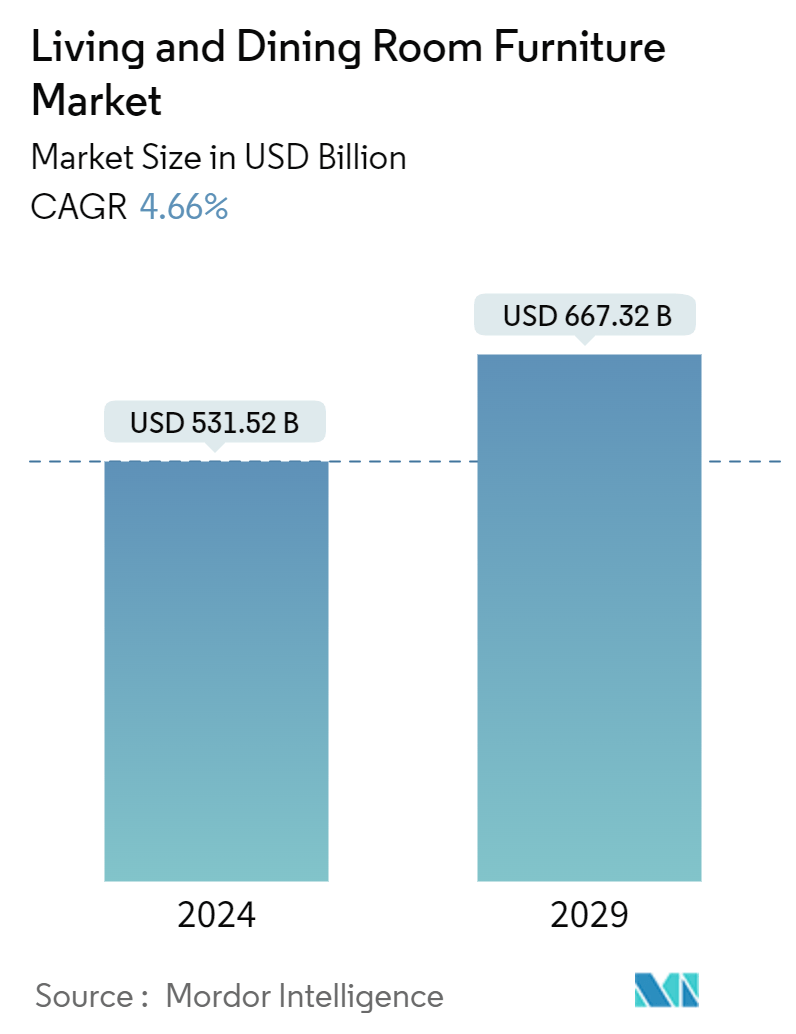Market Size of Living And Dining Room Furniture Industry

| Study Period | 2020 - 2029 |
| Market Size (2024) | USD 531.52 Billion |
| Market Size (2029) | USD 667.32 Billion |
| CAGR (2024 - 2029) | 4.66 % |
| Fastest Growing Market | Asia Pacific |
| Largest Market | North America |
Major Players
*Disclaimer: Major Players sorted in no particular order |
Living and Dining Room Furniture Market Analysis
The Living And Dining Room Furniture Market size is estimated at USD 531.52 billion in 2024, and is expected to reach USD 667.32 billion by 2029, growing at a CAGR of 4.66% during the forecast period (2024-2029).
Changing interior design trends, such as minimalist, Scandinavian, industrial, or vintage styles, influence the design and furnishings of living and dining rooms. Consumers often seek furniture and decor that align with popular design aesthetics. Demographic factors such as age, household size, income levels, and lifestyle preferences impact the demand for living and dining room furniture. For example, millennials may prefer multifunctional and space-saving furniture for smaller urban dwellings, while affluent households may invest in luxury and high-end furnishings. Housing market trends, including new construction, home renovations, and housing affordability, influence the demand for living and dining room furniture. Changes in housing preferences, such as open-concept floor plans or smaller living spaces, shape furniture choices and layouts. Growing awareness of environmental issues prompts consumers to seek sustainable and eco-friendly furniture options for their living and dining rooms. Sustainable materials, ethical manufacturing practices, and eco-certifications are increasingly important considerations for environmentally conscious consumers. Technological advancements, such as smart home technology, integrated entertainment systems, and wireless charging capabilities, influence the design and functionality of living and dining room furniture. Consumers may prioritize furniture that seamlessly integrates with their digital lifestyles and home automation systems. The proliferation of online retailers, brick-and-mortar stores, and furniture marketplaces provides consumers with diverse shopping options for living and dining room furniture. E-commerce platforms offer convenience and a wide selection of products, while physical stores allow consumers to experience furniture in person before making a purchase.
Overall, the living and dining room market is influenced by a combination of design trends, demographic shifts, housing dynamics, economic conditions, sustainability considerations, technological advancements, retail channels, and cultural influences. Understanding these factors is essential for furniture manufacturers, retailers, and designers to meet consumer needs and stay competitive in the market.
Living and Dining Room Furniture Industry Segmentation
A living room is a residential house or apartment for relaxing and socializing. The living room may contain furnishings such as a sofa, chairs, occasional tables, coffee tables, bookshelves, electric lamps, rugs, or other furniture. Dining rooms always include a table, chairs, and sometimes a buffet (or sideboard) and a china cabinet or cupboard. The report covers a complete background analysis of the living and dining room furniture market. It includes the parental market assessment, emerging trends by segments and regional markets, significant changes in market dynamics, and a market overview.
The living and dining Market is segmented by type, end-user, distribution channel, and geography. By type, market is sub-segmented into seats and sofas, chairs, tables, and others. The end-user market is sub-segmented into household and commercial, The distribution channel market is sub-segmented into departmental stores, independent furniture retailers, factory outlets, online, and others, and the geography market is sub-segmented into North America, South America, Asia-Pacific, Middle East & Africa, and Europe. The report offers market sizes and forecasts in value (USD) for all the above segments.
| By Type | |
| Seats and Sofas | |
| Chairs and Tables | |
| Others |
| By End User | |
| Household | |
| Commercial |
| By Distribution Channel | |
| Departmental Stores | |
| Independent Furniture Retailers | |
| Factory Outlets | |
| Online | |
| Others |
| Geography | |
| North America | |
| South America | |
| Asia-Pacific | |
| Middle East & Africa | |
| Europe |
Living And Dining Room Furniture Market Size Summary
The living and dining room furniture market is poised for significant growth, driven by evolving design trends and changing consumer preferences. As interior design styles such as minimalist, Scandinavian, and vintage gain popularity, consumers are increasingly seeking furniture that aligns with these aesthetics. Demographic factors, including age, household size, and income levels, further influence demand, with millennials favoring multifunctional furniture for urban living spaces and affluent households opting for luxury furnishings. The housing market also plays a crucial role, with trends like open-concept floor plans and smaller living spaces shaping furniture choices. Additionally, there is a growing emphasis on sustainability, with consumers prioritizing eco-friendly materials and ethical manufacturing practices. Technological advancements, such as smart home integration, are also impacting furniture design, as consumers look for products that complement their digital lifestyles. The market is further shaped by the proliferation of diverse retail channels, including e-commerce platforms and brick-and-mortar stores, offering consumers a wide range of shopping options.
E-commerce is rapidly becoming the dominant distribution channel in the living and dining room furniture market, driven by technological advancements and increased internet access. This shift has led to more competitive pricing dynamics, as online retailers leverage direct sourcing models to reduce costs and offer lower prices. Promotions and discounts during major sales events further incentivize bulk purchases, contributing to price reductions. In regions like Asia-Pacific, factors such as rising residential construction and increasing disposable income are expected to boost market demand, although challenges like skilled labor shortages and infrastructural issues may hinder growth. The market is characterized by a mix of large and small players, with major companies competing through product breadth and effective marketing, while smaller firms focus on niche segments and superior customer service. Recent industry developments, such as acquisitions and new product launches, highlight the ongoing evolution and competitive nature of the market.
Living And Dining Room Furniture Market Size - Table of Contents
-
1. MARKET DYNAMICS
-
1.1 Market Overview
-
1.2 Market Drivers
-
1.3 Market Restraints
-
1.4 Value Chain / Supply Chain Analysis
-
1.5 Porter's Five Forces Analysis
-
1.5.1 Bargaining Power of Suppliers
-
1.5.2 Bargaining Power of Buyers/Consumers
-
1.5.3 Threat of New Entrants
-
1.5.4 Threat of Substitute Products
-
1.5.5 Intensity of Competitive Rivalry
-
-
1.6 Insights on Trends Influencing the Living and Dining Room Furniture Market
-
1.7 Insights on Technological Innovations in the Market
-
1.8 Impact of COVID-19 on the Market
-
-
2. MARKET SEGMENTATION
-
2.1 By Type
-
2.1.1 Seats and Sofas
-
2.1.2 Chairs and Tables
-
2.1.3 Others
-
-
2.2 By End User
-
2.2.1 Household
-
2.2.2 Commercial
-
-
2.3 By Distribution Channel
-
2.3.1 Departmental Stores
-
2.3.2 Independent Furniture Retailers
-
2.3.3 Factory Outlets
-
2.3.4 Online
-
2.3.5 Others
-
-
2.4 Geography
-
2.4.1 North America
-
2.4.2 South America
-
2.4.3 Asia-Pacific
-
2.4.4 Middle East & Africa
-
2.4.5 Europe
-
-
Living And Dining Room Furniture Market Size FAQs
How big is the Living and Dining Room Furniture Market?
The Living and Dining Room Furniture Market size is expected to reach USD 531.52 billion in 2024 and grow at a CAGR of 4.66% to reach USD 667.32 billion by 2029.
What is the current Living and Dining Room Furniture Market size?
In 2024, the Living and Dining Room Furniture Market size is expected to reach USD 531.52 billion.

